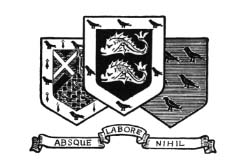
BHASVIC has inherited the mantle of the former Brighton, Hove & Sussex Grammar School which for nearly 120 years produced many distinguished lawyers, politicians, generals, admirals, engineers, artists, musicians, sportsmen and teachers.
The PAST & PRESENT ASSOCIATION unites that proud tradition with the tradition already being created by the Sixth Form College.
Whether you have already left the College, or are about to leave, or even if you left the Grammar School many years ago, why not join the Association. The membership fee is only £5 p.a. and it will help you keep in touch with friends from either your College days or your days at the Grammar School.
There is an annual reunion, usually a lunch but occasionally a dinner, as well as a magazine, Past & Present, which is published annually. There is also an annual golf competition.
The editor of the Past & Present magazine is Mark Gillingham, 11 Elrington Road, Hove BN3 6LG.
The Membership Secretary is Bruce Rawlings, 48 Cleveland Road, Worthing, BN13 2ES.
Tel: 01903 264150, Email: rawlings@mistral.co.uk
Download the Past and Present Association application for membership form as a PDF which you can then print out.
YouTube Video: https://youtu.be/a0CKkoQiN7M
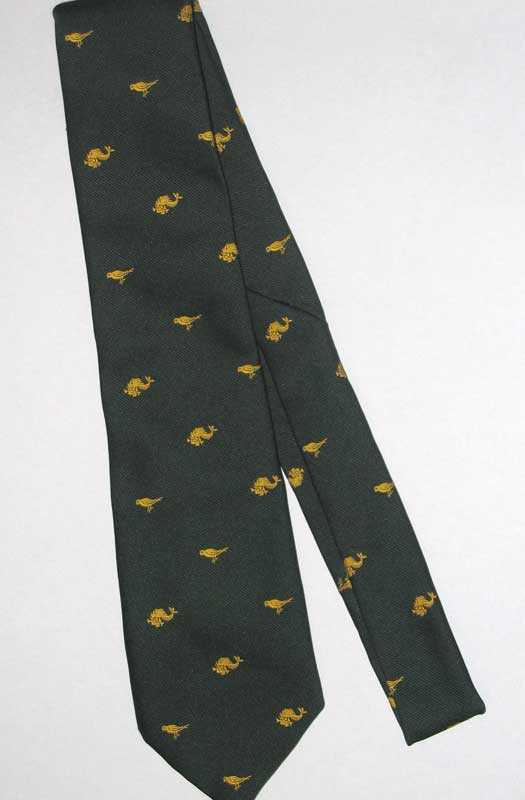
Available at £10 each plus postage from:
Christopher Bennett
4, Windlesham Road
Brighton
BN1 3AG
Tel: (01273) 739728
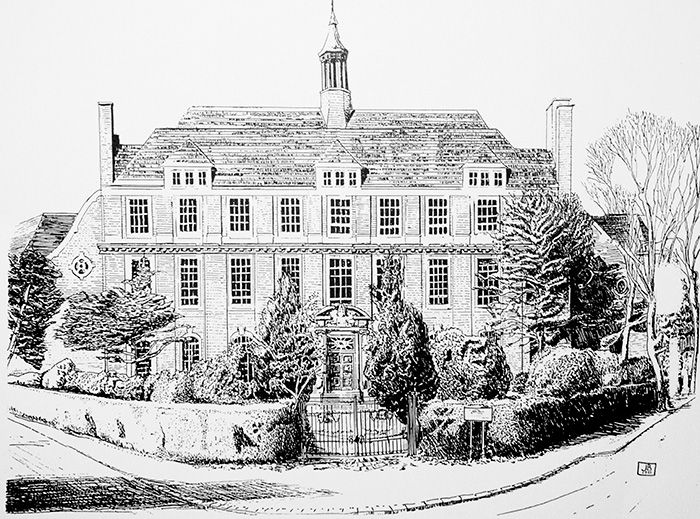
Reprinted from the Past & Present magazine of July 1939
During the coming holidays, Mr Louis Ginnett, ROI, hopes to place in position as his own gift the last of the panels in the School Hall. To commemorate this remarkable achievement, the Editor has offered the opportunity of placing on record the progress of the scheme, and of writing an appreciation of the message which the artist has conveyed to one who is a mere layman in art, but has repeatedly used each successive panel to bring home more vividly to recent generations of Grammarians the Story of Man in Sussex.
Two extracts from Past and Present explain the origin of the scheme: 'On January 20 1913, the Governors of the School accepted the Old Boys' gift of carrying out in part Mr Louis Ginnett's scheme for the decoration of the new School Hall with a series of panels illustrating the History of Man in Sussex, …. The School architect, Mr S B Russell, FRIBA, cordially approved the scheme of decoration and remodelled the wood panelling of the Hall so that painting and panelling shall constitute one harmonious whole'. Thus in August it will be possible, for the first time, to see the Hall as the architect conceived it. Throughout, the artist has kept this aim in view and has shown marked skill in overcoming the limitations, as well as in making full use of the opportunities which such a scheme involved.
The first decision sanctioned the three panels at the south end of the Hall - the middle one, above the portrait relief by Alfred Drury, RA, as part of the Marshall Memorial, and the two flanking ones as gifts of the Old Boys to the new School. On the occasion of the first reunion to be held in the new buildings, the 47th Annual Reunion, on Saturday, October 25 1913, the President of the Old Boys' Association, Mr T. Read, BA, BS'c, unveiled the Marshall Memorial panel, and spoke of the scheme for continuing the work. Early in August 1914, the artist had put the other two into position, and 'was busily engaged (on August 7) in putting the finishing touches to his paintings, when an officer of the RAMC arrived and took possession of the School.'
During the War, Mrs Read died, and Mr Read, on the re-opening of the School after it had ceased to be a military hospital, presented the fourth panel as the Ellen Read Memorial, in memory of his wife, 'the school-mother, 1894-1918.' To those who knew her, and especially to many a Marshall House boy, there could be no fitter memorial than one in the School Hall, between that to E J Marshall and that to the sons of the School who gave their lives in the War, 1914-18. For it is to them that the fifth panel, with its flanking rolls of honour, was dedicated by the Right Rev H K Southwell, Bishop of Lewes, and former Assistant Chaplain-General to the Forces, in February 1923, when Lt Col H C Saunders, DSO, presented it to the School on behalf of the Old Boys.
With the sum left over from the War Memorial Fund, augmented by gifts from parents and Old Boys, the sixth panel was commissioned, in June 1927, and the artist himself spoke to the School on his scheme when it was first put on view at the beginning of the Autumn Term, 1928.
On November 20, 1936, at the Annual Prize Giving, Mrs Mills unveiled the seventh and eighth panels as part of the Memorial to her father, Headmaster from 1899-1924. She herself, and other members of the family, helped considerably to make this possible, as an addition to the furnishing and equipment of the new Library.
Finally, in 1939, as his own tribute to his School, and former master, the artist himself presented the ninth and last panel to complete the Hall as designed by the architect. Seldom can a School Hall have had such an aid to build up a tradition - the Story of Man in its own county designed and executed by an artist who himself was an Old Boy and presented by those who held dear the memories of E J Marshall, Ellen Read, the Old Boys who gave their lives in the War of 1914-18, and of him who bridged the whole period, Thomas Read, Boy, Assistant Master, Headmaster and President of the Old Boys' Association.
Decorative Panels in the College Hall 1913 - 1939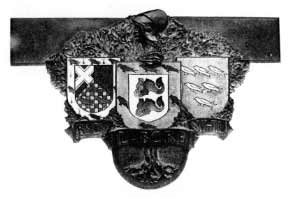
Subjects of the Panels
With the completion of the last panel it is at length possible to appreciate the artist's message as a whole. When speaking at the beginning of the Autumn Term, 1928, he told the School of his feeling that, through all the changes of history, there remained something enduring in types of character. Again and again he brings this out, not only in his principals, but also in the crowds, whether they surround the Roman prefect, William the Conqueror, Henry III, William Coxon, or George IV.
Prehistoric Man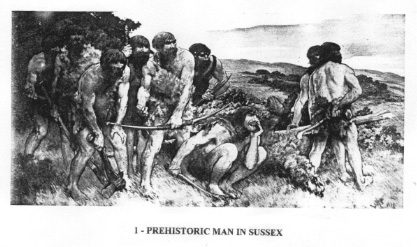
In 1912 and 1913, when the earliest panels were being discussed, Sussex had just become the centre of prehistoric interest as a result of the recent discovery of the Piltdown skull. Already the great flint mines of Cissbury were well known. So the series begins with primitive man returning to his Downland habitation from a raid in the Wealden forest in search of prey. He is just beginning to use those lofted stone axes which, with other tools, were helping him to take the first step along the road to civilisation, by tilling the soil and keeping herds and flocks.
Marshall Memorial Panel 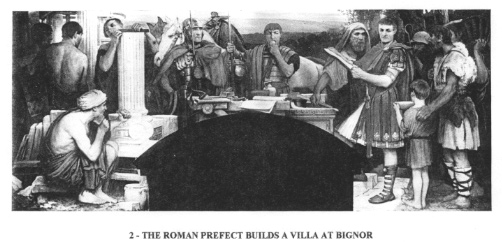
At the tenth milestone along the road which leads from Chichester to London the Prefect of the Province built for himself a house when Hadrian was Emperor. The prefect with two of his men in attendance has ridden to Bignor to inspect the work on his new villa and to discuss further plans with his architect. Native onlookers watch him and the foreign workmen who are fashioning stone for the building – a symbol of Roman order brought to an outlying province.
The Third Panel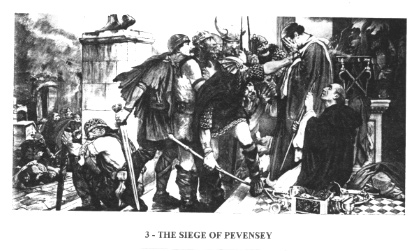
The third panel brings out vividly the end of that order. ‘In this year Aella and Cissa besieged Andredesceaster (Pevensey) and slew all that dwelt therein, so that not one Briton remained alive there. A.D. 490.’ For many a year the marauding Saxons had ravaged these shores and burnt towns and villas. As early as the end of the third century the governor of the province had reorganised the defences by building the forts of the Saxon shore. When the Romans left Britain to its own resources, the raids grew more frequent, until at last the Saxons felt strong enough to stay and destroy the symbols of Roman power and Christianity. After a siege the fort fell and the inhabitants took refuge in the temple, and sheltering behind their horrified bishop, saw the statue of the emperor overthrown and the altars and symbols of their faith broken and derided by the ruthless pagans.
The Ellen Read Memorial
Through many ups and downs these Saxons, with later invaders, built up a Christian civilisation of their own which, in its turn, had to meet successive raids of Northmen until it fell before the Knights of William of Normandy. After the battle of Hastings, a chronicler tells how ‘the mother of Harold, bowed down by agonies of grief, sent to the Duke, himself, craving for his pity for an unhappy woman bereft of her three sons, and begged him to return to a widow the body of one of the three she had lost; or, if it pleased him, she would hand over the weight of the body in pure gold. But the angry Duke unhesitatingly refused her request, swearing that he would bury it beneath the sands of the seashore’. Such a burial in unconsecrated ground was the lot of those who died excommunicate, as Harold did for breaking his oath. Thus another invader, backed by the Hildebrandine reforming movement in the Church, set his hand to the task of moulding an English nation to his will.
The completion of the War Memorial
The War Memorial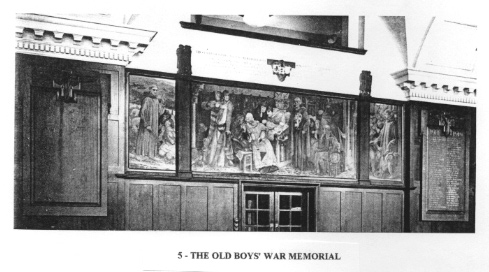
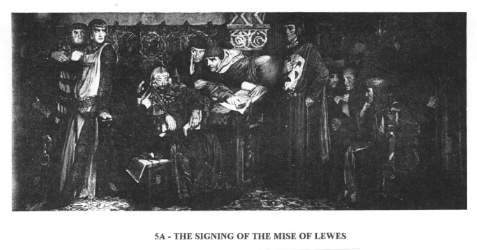
This panel, with its two small flanking panels, shows the characteristics of this English nation, at the height of the Middle Ages, under the influence of the Friars, and the growing middle classes in town and country. When Henry III and his foreign favourites tried to govern in the interests of themselves and the Papacy, Simon de Montfort called on these middle classes to curb the King and defeated him at Lewes. ‘Read, ye English, this record of the battle of Lewes, under the protection of which you live defended. Because if victory had fallen to those who were this day conquered, they would have held the memory of the English in low esteem.’ (The Song of Lewes). Simon de Montfort, leaning heavily on his stick, attended by the Earl of Gloucester, and other nobles, forced the King, in the presence of the indignant captive, Prince Edward, to sign the Mise of Lewes, promising to dismiss foreign favourites and to cease to be the tool of the Papacy.
In the one flanking panel, the friar passes through the field, blessing the kneeling peasants and their flock. ‘Ah, could your Holiness but see with what devotion and humility the folk hasten to hear from these men the Word of life, to confess their sins and to be taught.’ (Letter to the Pope from m the Bishop of Lincoln). In the other the angry mob hunt the criminal to 'the sanctuary of the Church .… by fleeing to which, an accused man, when he reaches it, has complete protection.’
Part of the Read Memorial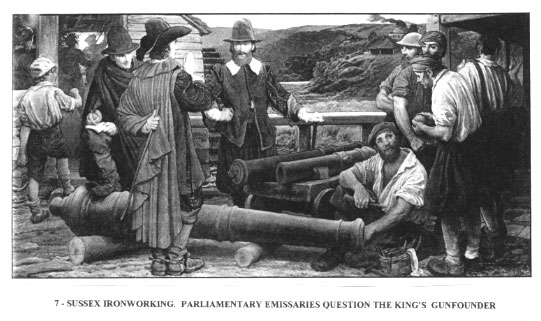
Read Memorial
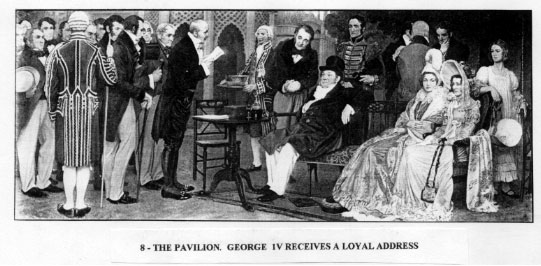
Sussex has ceased to be a great industrial centre, but the old fishing village of Brighthelsmstone has gained sudden fame when the Prince Regent and his Court decided to make it a bathing resort and holiday centre. When the Regent at last became King on the death of the aged George III, the inhabitants of the town sought the first suitable opportunity to express their loyalty and sense of gratitude to His Majesty, sitting with members of his Court on the lawns in front of the Royal Pavilion. Among the crowd supporting the reader of the address are descendants of the same characters we have seen under other circumstances. ‘On the occasion of his birthday, His Majesty was graciously pleased to receive a deputation from the inhabitants of the town, and condescended to hear an humble and loyal address, expressing in the most particular and unequivocal terms their confidence, gratitude and affection. Brightelmmstone. Augusts, 1821..’ (Local newspaper)
The gift of the Artist. "Full Circle"
The scheme is completed and the artist links all together. On the heights above the town, seen in the background, near the camp on Hollingbury Golf Course, excavators turn up a skull of one of the ancient Britons depicted in the first panel. Watching them are people in the dress of 1926 – golfers, a motor cyclist, and a Grammar School boy among them. One of the excavators holds up the skull for the inspection of him around whom so much in this Hall centres – Thomas Read. Educated under E J Marshal, he had taken part in the march from Grand Parade to Buckingham Road; he had worked for years to bring to fruition his scheme for the new school; he had led the school from Buckingham Road to Dyke Road. To the artist he must have been one of those Sussex characters who helped in his quiet way to build England, and here in this Hall his memory is surrounded by memorials to many of those to whom he devoted his life.
Economics Commentator and City Editor for the Daily Mail Alex Brummer has a new book, ‘Great British Reboot’ published by Yale.
A Voyage Down the Years - A turbulent life on Land and sea by Guy Warner
Guy Warner pioneered the introduction of command computers into submarines. How this came about and his follow up in the defence industry are revealed in this enthralling memoir. However, the call of the sea was not to be denied, and he went on to become a passionate and competitive sailor in his own yachts, in which sailing escapades abounded. He has also needed resilience in his colourful voyage through life, as it has been troubled along the way by family tragedies.
A story of the ups and downs of an unusual life told with humour, honesty and frankness.
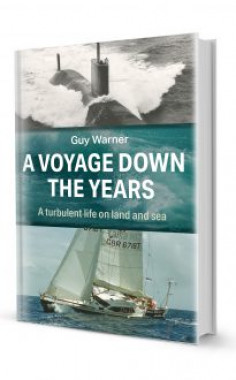
Available to buy through: mereobooks.com
My Life in Science Where Psychopharmacology took me by Ian Stolerman
Dear Friends
I trust this email finds you well and active. You might be amused to know that I have written an autobiography, a book that is primarily an account of my working life. It would be somewhat presumptuous if I was to assume that you would be interested in it, but it’s a possibility! My recollections of Brighton Grammar School are included in Chapter 1, warts and all. The book is self-published and can be purchased as a printed hardback book from blurb.co.uk. It can be found at http://www.blurb.co.uk/bookstore/invited/7003099/a2cc46d497eb0ff90e6ba79abc35742206b65dfc
The book describes my life as a scientist who was prominent and influential within his field and gained much satisfaction from his career. It is an account of my life at school and at several outstanding universities in England and the USA. At each stage it relates my work to personal circumstances and aims to impart something of the flavour of my career, both its pleasures and its pains, and the personalities that were major influences on its development. It outlines fragments of the science in a way that makes them readily accessible. It reveals for the first time events that were kept ‘under wraps’ until now, notable among them being touch-and-go fights to secure funding for the research from both British and American sources and fraught relationships with tobacco companies arising from studies of nicotine and tobacco addiction. Above all, it is about diversity; the diverse teaching and administrative tasks that university-based scientists take on in addition to research, the diverse countries from which members of research groups originate, and the diversity of work for international societies that are vital for the progress and expansion of research fields. There are 224 pages and fifty illustrations.
Kindest regards
Ian Stolerman
Emeritus Professor of Behavioural Pharmacology
Institute of Psychiatry, Psychology & Neuroscience
King’s College London
Photo gallery: https://exaktafan.smugmug.com
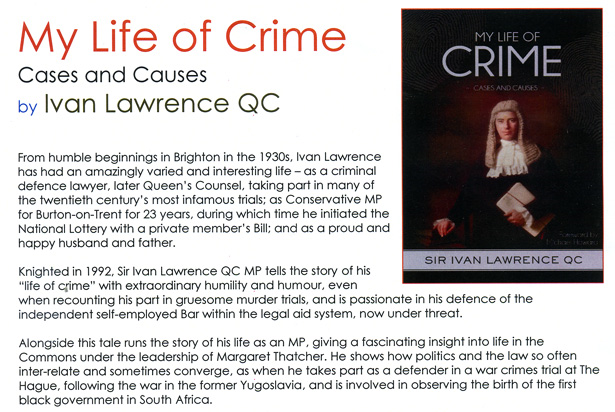
Download book order form
If you were a pupil at BHASVIC or Brighton Hove and Sussex Grammar School for Boys (as it used to be before becoming a sixth form college) we would encourage you to sign up to our Alumni Network database by clicking on this link Alumni Network
Signing up will enable you to come into college to share your current work expertise, offer work experience or act as a mentor to our students.
